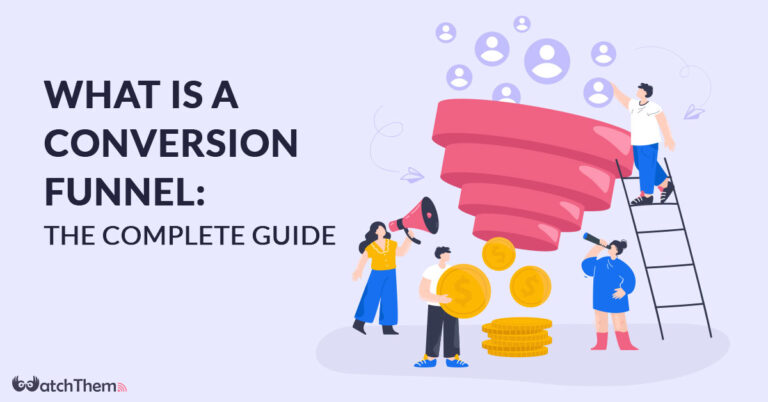Page Contents
Many business owners get frightened when they hear the term “conversion funnel.” Let’s assure you right now before we start that if you have an online shop and sell products or services online, you already have a conversion funnel! However, having the conversion funnel is not really a concern, but optimizing it for maximized revenue is!
Also, improving your conversion funnel not only helps you with conversion rate optimization rate but will create a better customer journey for your customers as well.
In this article, we will explain what a conversion funnel is, how to create it, its different stages, its structure, and strategies for optimizing every stage.
Note: WatchThemLive is a behavioral analytics tool that helps you optimize your conversion funnel stages to earn maximized revenue. Stay with us to learn how.
What Is a Conversion Funnel?
Conversion funnel or sales funnel is an eCommerce term that describes the visualization of the steps your potential customers go through on their way to purchase your products or services. Keep in mind that a conversion doesn’t happen only when a customer purchases a product or subscribes to a service; it can be any desired action.
The conversion funnel helps you understand and visualize your customers’ path to conversion. This process is called a funnel because it has different steps that need to be taken for the success of the next steps. As a marketer, your job is to guide the customers through these steps successfully until they reach the conversion point.
A perfect conversion funnel doesn’t trap users in a page; they should always have other options, such as an exit button or a go-back button. It should also have visible, available, and functional options and elements so the users won’t get confused and can go to the next step effortlessly.
What Are the Steps in the Conversion Funnel?
A classic conversion funnel has four stages. During each stage, your customers can leave you for competitors. That’s why you need to optimize each of these stages to increase your revenue. Let’s get to know the stages first.
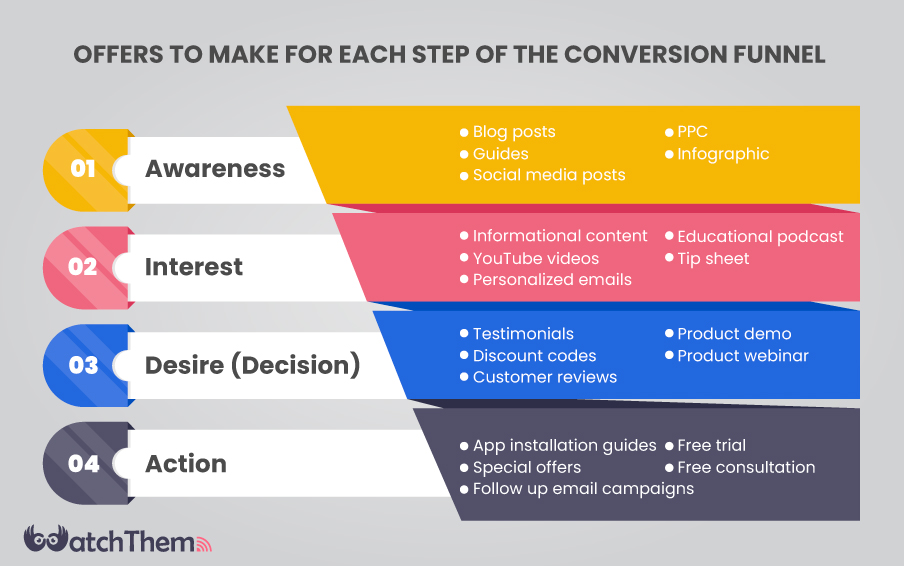

Stage 1: Awareness
The first step of the conversion funnel is awareness. At this stage, your potential customers become aware of your brand’s products and services.
Let’s review this from customers’ point of view. Here, customers are becoming aware of their problems and are looking for solutions. You should know that you are not their only option. They’re currently researching to find the best option available.
They do their research by searching queries. If you want to be seen, then you should start giving them information by writing blog posts, guides, etc. You can also use social media and PPC to build brand awareness. Aside from these tactics, there are other top-of-funnel marketing (TOFU) tactics you can use.
Stage 2: Interest
The second stage of the conversion funnel is interest. In this step, the customer is becoming interested in your brand, but they’re not sure whether they should purchase from you or not. Here, your job as a marketer is to hang on to them and don’t let them go! You should show them why it is you that they need to purchase from.
In this stage, they might have given you their email address or followed you on social media. Your potential customer is now a lead. So, you have to start using middle-of-funnel marketing tactics (MOFU). You can send them personalized emails, use appealing YouTube videos, and post informational content on your social media platforms to add value.
Stage 3: Desire (Decision)
The third stage of the conversion funnel is desire. In this step, your lead is now a full-fledged prospect. This means that not only they’re interested in your products, but they’re also considering purchasing from you. However, they’re still not sure.
To close the deal, you need to use bottom-of-funnel marketing tactics (BOFU). These tactics can be using testimonials, discount codes, customer reviews, and including pricing pages, demos, etc.
The point is to show your prospect what it looks like to be your customer and the benefit they gain from purchasing from your brand by sharing happy customers’ experiences. Prospects need to be sure that they’re making the right choice choosing you over other options.
Stage 4: Action
The fourth and last stage of the conversion funnel is action. This is where you close the deal, and your prospects turn into customers. There is not much you can do in this step since it’s all up to the prospects whether they want to make a purchase or not. However, you should teach them how they can successfully benefit from your products or services. Here, you can use app installation guides, follow-up email campaigns, special offers for their next purchase, etc.
Don’t let go of your customer after sealing the deal! According to statistics, existing customers are %50 more likely to buy your products compared to new customers since they already trust you and know that your services will solve their problems. So, you need to turn your customers into loyal ones.
Offering superior customer service can help you a lot in this matter. Some brands won’t even check their messages after they closed the sale! Don’t be like them! Your customers might have questions regarding using your web app or are facing a problem with an element. Answer their questions patiently and help them get the full potential of your services. This step is especially important if you have a subscription-based service where you benefit from renewing deals and repeat customers.
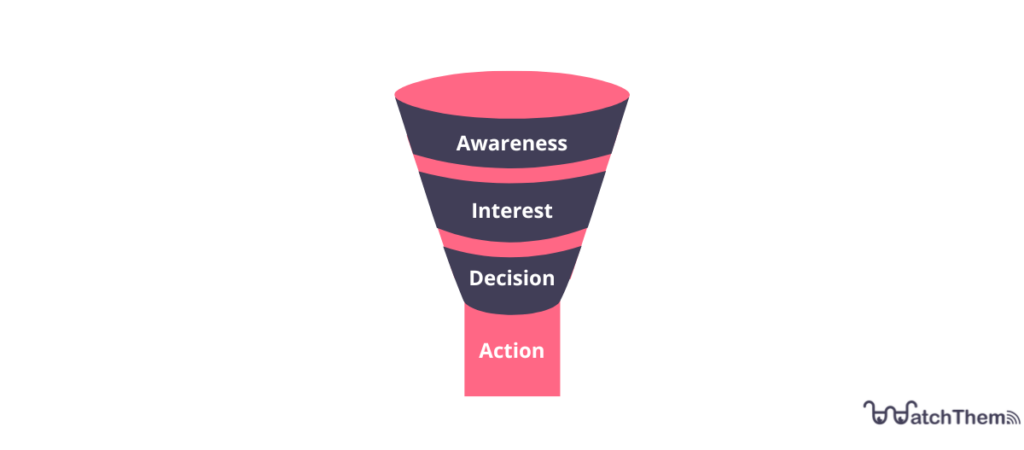

How to Create a Conversion Funnel
If you’ve been thinking about how to create a conversion funnel, then you came to the right place! Here’s a step-by-step guide to creating a successful conversion funnel.
1. Attract the Right Type of Target Audience
Instead of just pouring users into your conversion funnel, you need to target the right audience who are actually interested in your products.
2. Decide on Your Final Goal and Buyer Journey
You need to optimize your conversion funnel because you need more conversions and that directly depends on your buyer’s journey. So, in this step, you have to determine three things:
- Your current buyer’s journey
- The goal you want to reach or your desired action you want the users to take
- The changes you need to make to your current buyer’s journey to increase the chance of customers completing your desired action
When you know what you want and your desired actions, you can map it out as a conversion funnel.
3. Design an Effective Landing Page
Visitors form their first impression from your landing page, and I’m sure you’re aware of the importance of first impressions and how they can make or break a business. An appealing landing page that catches users’ attention is an important part of creating a successful conversion funnel.
4. Nurture Your Leads
After visitors enter your website, you have to engage and educate them. By doing this, you will increase brand loyalty and increase the chance of them purchasing from you. You can nurture your leads by sending personalized emails, posting on social media platforms, etc.
5. Create Interest and Desire
You can create interest and desire by using different methods, such as writing compelling content. There are different types of content you can use, such as product emails, video content, or blog posts.
6. Use Special Offers
Your prospects can leave your conversion funnel at any moment. To make sure that they stay on your website, try to offer discount codes, free delivery, etc.
7. Examine Your Funnel
To make sure that your funnel is performing well, you have to test your funnel from top to bottom. To do this, you should analyze your landing pages, test your CTAs and other elements, conduct usability testing, etc. To further test your conversion funnel, you can measure its metrics, which we will review in the next section.
Now you have a perfectly fine conversion funnel! Well done!
What Are the Conversion Funnel Metrics?
Funnel metrics allow you to measure the effectiveness of your conversion funnel. They also help businesses to find and fix the issues in their funnel. Let’s see what important funnel metrics are.
1. Number of Entrances
This is a top-of-funnel metric that shows the total number of users who entered your conversion funnel in a specific period of time. The tricky part is to determine where your funnel entry is.
2. Number of Leads
Not everyone who enters your sales funnel is a lead. When a user shows interest by following you on social media or dropping their email address, they become a lead.
3. Conversion Rate
Conversion rate is the percentage of users who completed your desired action, such as signing up for a weekly newsletter or purchasing a product. You can measure your conversion rate by dividing the number of users who took your desired action by the whole number of visitors and multiplying it by 100.
4. Costs
In order to become successful, a business has to pay for its activities. You have to measure your costs to understand if your revenue is in line with it.
5. Revenue
You also need to track your revenue and ROI. This helps you understand which channels are bringing the most revenue for you so you can focus on them.
6. Duration of the Sales Process
The shorter it takes for the customer to complete a purchase, the healthier your sales funnel is.
7. Funnel Drop-Offs
A funnel drop-off happens when a user leaves your conversion funnel without completing their purchase. You can measure your funnel drop-offs by subtracting the number of users who entered the first step of your funnel by the number of people who are at the current funnel stage.
How to Do a Conversion Funnel Analysis
Funnel analysis is the process of tracking users’ interactions with your website at each step. It helps you figure out what’s stopping users from completing their task, leading to a better customer journey.
To conduct funnel analysis, you can use Google Analytics that gives you numerical data or a behavior analytics tool like WatchThemLive. Behavior analytics tools let you easily understand user behavior since give you qualitative data besides numerical data. Let’s see how you can use them to conduct funnel analysis.
Funnel Analysis with Google Analytics
With Google Analytics, you can set your desired action as a goal. Then it will set up a funnel that includes each step leading to that goal. You can also enable your funnel visualization in the “Conversions” section under “goals.”
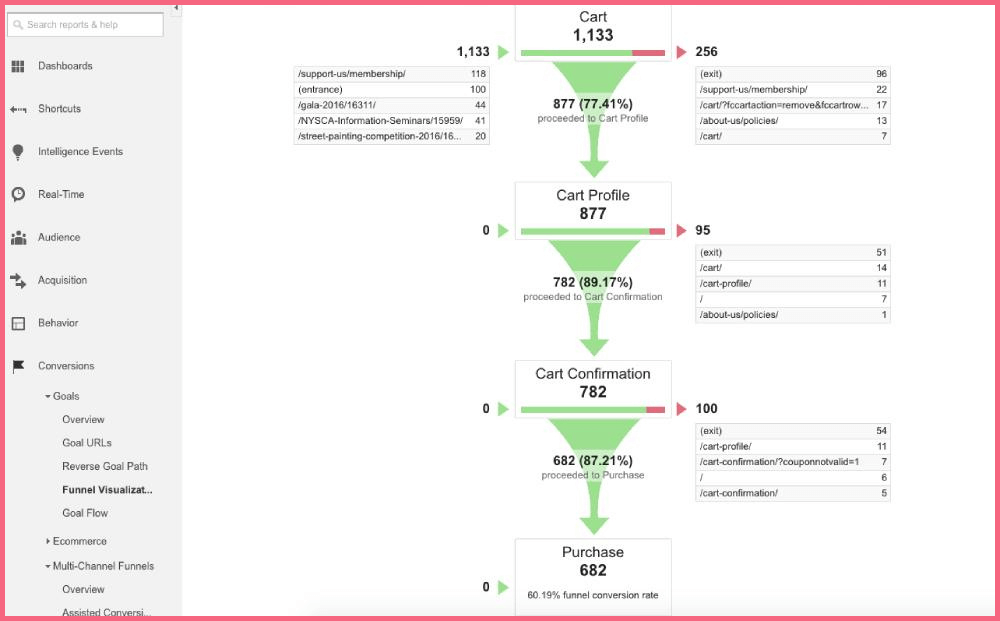

Funnel Analysis with WatchThemLive
A behavior analytics tool like WatchThemLive helps you easily watch and understand users’ interactions with your website. WatchThemLive allows you to identify your funnel drop-off points and fix them immediately. Let’s see its features and how they can help you.
Heatmaps
Heatmaps are a visualization of data that are very easy to understand and need no further knowledge. With heatmaps, you can see where visitors click the most and the least on a page. This way, you can figure out which elements are getting the most attention and which are getting ignored.
For example, if your CTA is not getting enough clicks and a less important button is receiving more attention, it means that this element is distracting users from your CTA. Then, you can change the CTA placement and remove the distraction.
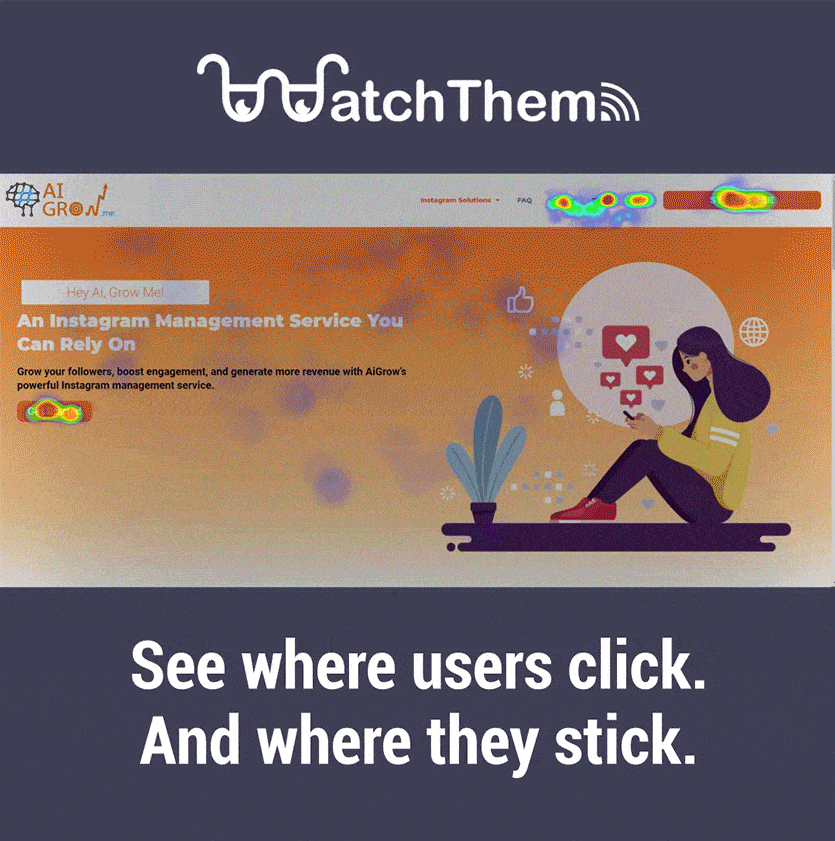

Session Replays
Session replay software records visitors’ interactions with your website, and you can watch them later. Watching these recordings has so many benefits as you can see the whole customer journey from the moment they enter your website until they leave it. You can see what problems your users encounter, what they like, and what makes them frustrated to leave your website. There’s no better tool to understand your users than session replays. Watch this video to see for yourself:
Goal Tracking
WatchThemLive also allows you to track goals. You can measure pageviews or set any custom event that you want.
For example, you can track your product pages and set a goal for understanding how many people visited them. If the number for a product page is higher than the others, it’s telling you to bring more products like that. Also, if you’re not receiving enough visits to your product page, then maybe there’s something wrong with it or it’s not visible enough. It was just an example and you can track any custom event or goal you have in mind. Constantly setting goals and tracking them helps you evaluate your website’s success and gives you motivation to be better than yesterday.
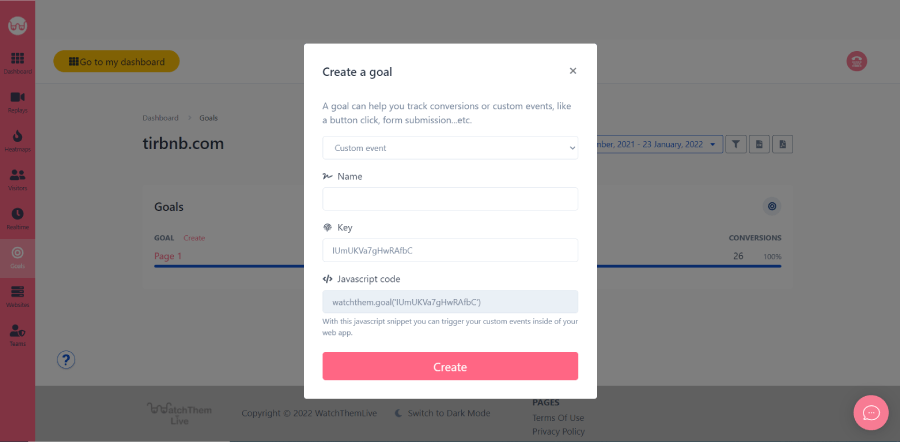

How to Find and Reduce Conversion Funnel Drop-Offs
After you’ve done your funnel analysis according to what we mentioned above, you know where your sales funnel drop-off points are. Now, we’re going to review four effective ways to fix your leaky sales funnel.
1. Targeting the Right Audience
You may notice that a lot of people enter your conversion funnel, but not all of them make it even to the next step. The reason may be that you’re not targeting the right audience who are actually interested in your products and services.
2. Engaging Your Potential Customers
You can keep your audience engaged by offering discount codes, sharing posts on social media platforms, sending emails, etc.
3. Providing Sufficient Information
If you want your users to go to the next step of your sales funnel, you have to provide them with the information they need to learn more about your brand. You can do this by adding social proof to your website or creating case studies.
4. Turning Your Customers into Loyal Ones
Stay in contact with your customers and answer any questions they have. Offer superior customer support and see the results for yourself!
How to Optimize a Conversion Funnel
Your conversion funnel can affect every aspect of your marketing activities. Most digital marketers don’t analyze and measure the success of their marketing funnel. Therefore, by doing so, you will be a step ahead of your competitors.
To analyze and optimize your funnel, first and foremost, you need to know your audience and their preferences. When you get to know them, you can develop practical strategies for funnel optimization. Let’s see how.
By watching and understanding user behavior on your website, you can learn their navigating patterns and redesign your website according to that. Keep in mind that you have to make sure your website is as easy to navigate as possible so your users can go through the conversion path without any obstacles.
Another way to optimize your conversion funnel is to eliminate CTA distractors. You can find them by creating heatmaps for your important pages (such as the product page) removing the distracting elements, and making your CTAs more visible.
Don’t forget about your landing page. It is where your customers gain their first impressions of your brand, which has a huge effect on your conversion funnel. If they like your landing page, they will move to the next step. But if they don’t, they will leave you within seconds and your bounce rate increases. Analyze, test, and redesign your landing page if necessary.
What Is a Good Funnel Conversion Rate?
The average funnel conversion rate is %3. However, average doesn’t mean good. A good funnel conversion rate is above %3, and a rate between 3.1%-5% is great. Keep in mind that even a 0.5% jump in your conversion rate is magnificent.
How to Calculate Funnel Conversion Rate
Now let’s see how you can calculate your funnel conversion rate.
Here is the funnel conversion rate formula:
Funnel conversion rate = (number of conversions / number of leads) * 100
To better understand how to use this formula, take a look at the example below:
You can use this formula for every stage of the conversion funnel to see what percentage of your users made it to the next stage.
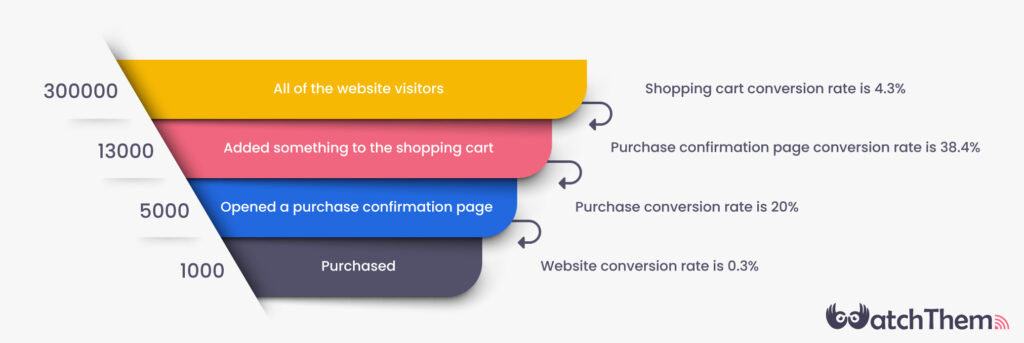

Conclusion
A conversion funnel should be able to attract visitors, nurture them, and turn them into customers successfully. If users are entering your conversion funnel and leaving it without completing a desired action, it means that there’s something wrong with your funnel.
In order to identify your conversion funnel issues and fix them, you can use a behavior analytics tool. WatchThemLive is the best one in the market. With its session replays, for example, you can watch the whole users’ journeys and see if they face any problems. Sign up to WatchThemLive and snag your FREE plan now!
In this article, we explained everything you need to know about the conversion funnel. Hope this was helpful and good luck!

